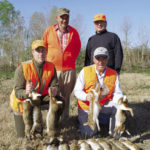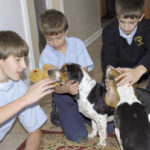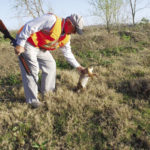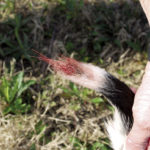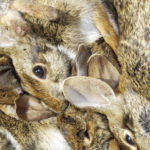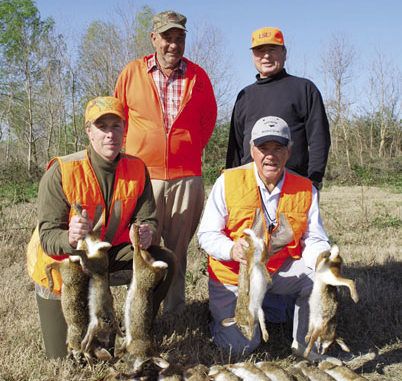
Think your beagles won’t hunt rabbits if you keep them indoors and let your kids play with them? Think again.
Die geschichte der schweinekopf Snoopy (The story of the pighead Snoopy) are the opening words of the 1967 rock-and-roll classic, “Snoopy vs. the Red Baron.” Snoopy the beagle, the only emotionally well-adjusted character that appeared in the 40-year life of the cartoon strip Peanuts, harbored the fantasy of being a World War I flying ace. His character indelibly branded affection for beagles in the average American.
Largely because of the cartoon strip, beagles are now without a doubt the most recognized and popular trailing hound breed in America. Few non-hunters can visualize what a plott or black & tan hound look like. In fact, few Americans even know that they exist.
Unlike many other breeds of dogs that once were used for hunting but now have the hunting instinct bred out of them by generations of breeding pets instead of working ability, beagles are still a serious breed of hunting dog.
When Deano Bonano of Metairie told me he hunts rabbits with his house pets, Godie and Dixie, I inveigled an invitation to join him on a hunt.
*******************************
Three hunters are scheduled to hunt with Bonano this morning, his regular rabbit hunting partner, Steve Danos, president of the Westbank Beagle Club, V.J. St. Pierre of Destrehan and St. Pierre’s friend Dudley Webre of Luling. Danos is bringing six more beagles from his own kennel, which holds about 30 beagles, most of which he runs daily.
On the trip across the Mississippi River from Metairie to Avondale, Bonano chats about how he got into beagling.
“I have three sons that are 14, 13 and 8 years old,” he says. “I was looking for a hunting sport that would keep my kids entertained, not just in the field but year round. Deer hunting is really tough on kids. They can’t sit still that long. It gets boring.
“Duck hunting has been rough the last few years; it’s not like it used to be. So when I met Steve with his beagles, it really caught my attention. My wife and I don’t keep our two beagles in a hard kennel outdoors. They have the run of our fenced yard, and are indoors a lot of the time. They are the kids’ pets and part of the family.
“Beagles are great around kids and have great temperaments. They love to play and they love to frolic. But they are intelligent dogs and really hunt hard too. We end up killing a lot of rabbits, and my family absolutely loves to eat them. They have a mild white meat.”
We meet the grinning Danos standing behind his truck with two crates of beagles going bonkers in the bed of the truck.
“They love to run,” Danos says. “That’s all they live for.”
Six little black, tan and white hound faces crowd the grating of the doors of the kennels. Their tails are beating a staccato on the plastic walls of their crates.
The day is beautiful — blue skies, cold and crisp, right after an atmosphere-clearing cold front has passed through. St. Pierre and Webre arrive right on time.
Bonano posts the two men at good shooting points in the small 2½-acre patch of scrubby grown-up old field, while Danos fusses over his hunting equipment. The dogs excitedly yelp and whine, creating a contagious enthusiasm.
With the hunters set, Bonano and Danos let the dogs out. Both drive their dogs by encouraging them with constant yelling, whooping and kittering. In truth, the dogs are so enthusiastic, they probably don’t need a lot of encouraging, but listening to the drivers is as enjoyable as listening to the dogs’ constant snuffling and yelping, mixed in with an occasional yodel, as they untangle old rabbit scent from new.
In what seems like less then two minutes, one dog opens up on a hot trail, and is immediately joined by his pack mates. As the dogs line out on the trail in full throat, Bonano yells alerts to the posted hunters. Almost immediately, a shot from a small gauge shotgun cracks the crisp morning air, and the first bunny is in the bag.
On his way to the dog pack to push them to start a new trail, Bonano spies a sneaker, and collects it with one shot. Sneakers, he explains, are rabbits that the dogs are not trailing but that are moving in response to the commotion caused by the dogs and hunters. Danos adds that if Bonano would have missed the sneaker, he would immediately have called the pack, unless it was on a hot trail, to the spot to run the sneaker.
“I want my dogs the work with me,” Danos says. “Some hunters hunt with their dogs instead of having their dogs hunt with them. Having dogs that will hunt with you and obey commands makes rabbit hunting a lot more fun.”
Danos keeps a close eye on his dogs. When he sees one not working where it should be, he scolds it and sends it to work. They listen.
“You need dogs that you can control,” he reiterates. “I also like dogs that hunt as a pack. I don’t like them hunting separate.”
The hard-working dogs jump another rabbit, and off to the races they go. They jump the rabbit so close to Bonano that he can’t safely shoot. The hotter the trail is the more excitedly the dogs bark. And this one is hot. Bonano and Danos know their dogs by voice, and can interpret what each one is doing by its vocalizations.
When a young dog opens up on a trail, they pay less attention than when an experienced dog is doing the talking.
“Young dogs will often have big noses and open up on a cold trail,” Danos says.
He considers a dog 1 to 2 years old as young and dogs 4 years old as being in their prime. By 6 to 7, he starts backing off hunting them as often, and says that if you get eight decent years out of a hunting beagle, “you are getting plenty.” Few live to 10.
When the dogs go silent while on a hot trail, it means the rabbit has changed direction or has been shot. If it is a direction change, the dogs, working as a loose pack, will search around the area for the redirected scent trail.
This rabbit bites the dust, and then another, and then another. The action never seems to stop. And neither do the drivers’ encouraging shouts to their dogs. Whoops that come out as “yewp” are common. Danos constantly chants “talley ho,” which to my untrained ears sounds like “daddy-o.”
Every once in a while, he slips in a “cha-cha-cha,” the old Cajun French encouragement for beagles. Bonano isn’t silent either, “git ‘em; git ‘em outta there; git ‘em; find ‘em.”
All four hunters shoot repeatedly every few minutes. The dogs’ hot trailing voices, punctuated by the percussion of gunshots, create musical chaos. A rabbit, with the hounds hot on his tail, actually runs between my legs.
So many rabbits! One could easily assume that this should be pristine habitat. But it has been well-used, and has felt the effects of the heavy hand of man. Scrubby stunted willows and tallow trees are scattered in dense stands of elderberry plants. Beneath this are dewberry briar vines and the green of winter weeds that grow on disturbed ground.
Decorating this less than scenic habitat are chunks of concrete, broken glass, cans, bottles, bent and rusty sheets of corrugated roofing tin, half-rotted boards and auto tires in singles and piles.
None of this seems to hurt the hunting, though. In fact one of the shooting hotspots on the small piece of ground is an overgrown 7-foot pile of discarded tires.
“Junk piles hold a lot of rabbits,” Bonano says.
By 9:15 am, Bonano and Danos start loudly trilling a rebel yell, the call to the dogs that tells them the hunt is over. As they come in, they actually look as if they are smiling, in spite of having bloody tail tips from their excited wagging in the briars.
The final tally for the four hunters is 15 big swamp rabbits in less than two hours. The entire hunt took place on a piece of ground less than three acres in size. Bonano’s two house pets, as he calls them, worked just as hard as Danos’ dogs of the same age, which is to say well.
With smiles, St. Pierre and Webre head out to St. Charles Parish to clean rabbits. Danos and Bonano water their pooches before retiring to a local coffee shop to talk about rabbit hunting and beagles. What else is there to talk about?
